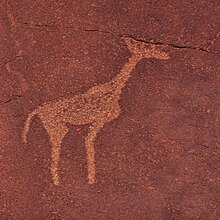Twyfelfontein is a ![]() UNESCO World Heritage Site of ancient rock engravings in the Kunene region of north-western Namibia.
UNESCO World Heritage Site of ancient rock engravings in the Kunene region of north-western Namibia.
Understand
edit
The site has been inhabited for 6,000 years, first by hunter-gatherers and later by Khoikhoi herders. Both ethnic groups used it as a place of worship and a site to conduct shamanist rituals. In the process of these rituals at least 2,500 items of rock carvings have been created, as well as a few rock paintings. Displaying one of the largest concentrations of rock petroglyphs in Africa, UNESCO approved Twyfelfontein as Namibia's first World Heritage Site in 2007.
Sandstone rocks at Twyfelfontein are covered by the so-called desert varnish, a hard patina that appears brown or dark grey. Engravings were effected by chiseling through this patina, exposing the lighter rock underneath. The indentations were created over the course of thousands of years. The oldest engravings might be as old as 10,000 years, and the creation of new works probably ended by the arrival of pastoral tribes around 1000 AD.
Get in
editFrom Khorixas drive about 72 km (45 mi) on the C39 road then turn left onto the D2612. Follow the D2612 for 14 km (9 mi) then turn right onto D3254. Drive this for 6 km (3.7 mi) then turn right onto D3214.
Fees and permits
editEntrance is N$80 for adults. Children are free.
Get around
editYou can only visit the engravings with a guide. Fortunately, this is included in the entrance fee. You'll need to tip your guide, however. Tours generally last between 30 and 80 minutes.
Sleep
edit- Twyfelfontein Country Lodge
- Madisa Camp
- Twyfelfontein Campsite
